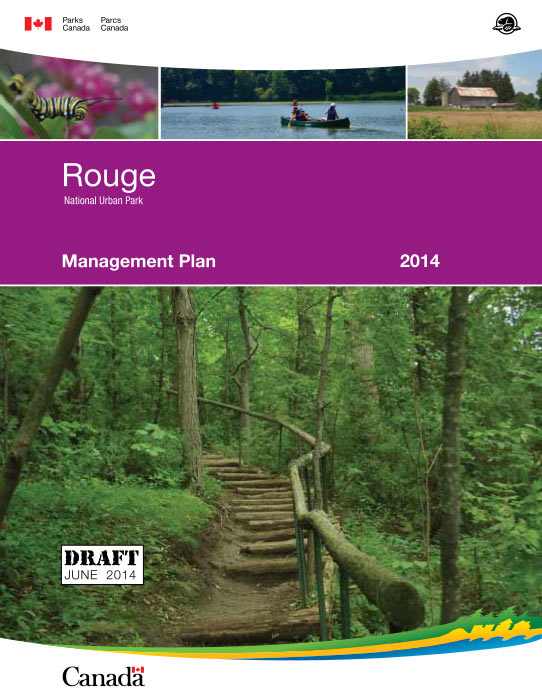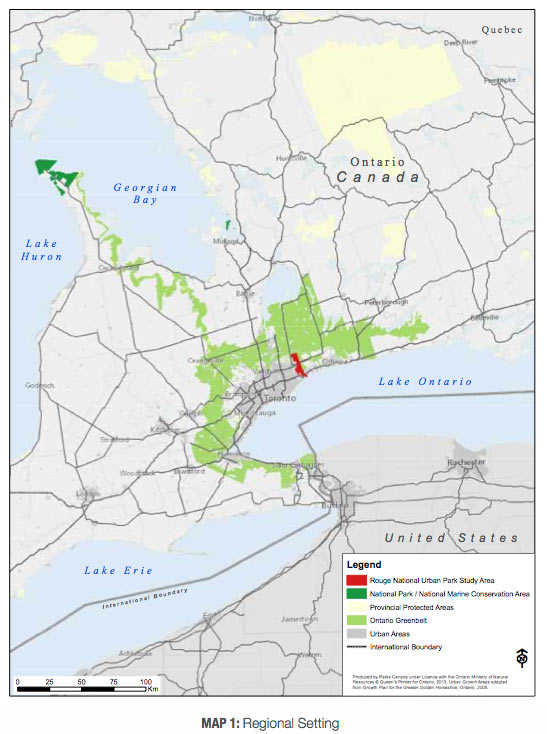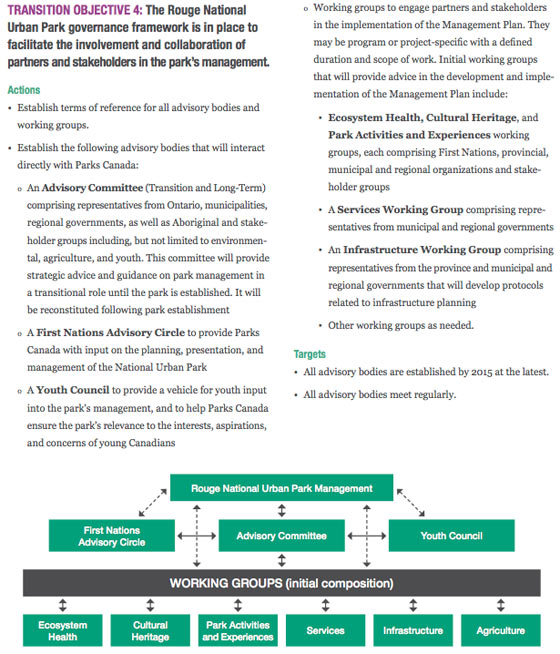This video presents QP Corneliu Chisu Rouge National Urban Park.
“We have tabled a bill in the House recently that would create the Rouge national urban park in the Greater Toronto Area. The park is near 20% of Canada’s population, enabling Canadians to connect with nature, culture and agriculture without having to travel far from their homes. This park would be 16 times larger than Central Park in New York City, and this action has been taken by our Conservative government to make this happen.”

The Rouge National Urban Park Management Plan: The Park Vision—A People’s Park
“Rouge National Urban Park celebrates and protects, for current and future generations, a diverse landscape in Canada’s largest metropolitan area. Linking Lake Ontario with the Oak Ridges Moraine, the park offers engaging and varied experiences, inspires personal connections to its natural beauty and rich history, promotes a vibrant farming community, and encourages us to discover Canada’s national treasured places. (Park Concept, 2012)”

The Rouge National Urban Park Management Plan will guide Parks Canada’s management of the park over a ten-year period.

All lands within the Park Study Area identified on Map 3 are included in the park except for the following:
- the hamlets of Cedar Grove and Locust Hill,
- privately-owned lands,
- Beare Road Park, and
- above-ground provincial, municipal and regional infra- structure (roads and road allowances, railway lines, hydro transmission corridors, storm water management facilities).
Unless otherwise specified, targets are to be achieved by 2024, the end of the 10-year life of this Management Plan.
- Baseline conditions refer to 2015 unless otherwise indicated.
“Parks Canada will manage the park not so much toward a particular end state, but in an adaptive way, so that it remains healthy and strong in the face of changes within and beyond its borders.”
Here are some of the Management Plan’s actions.
- Manage the park to enhance ecosystem health by way of an adaptive management approach that focuses on protecting existing ecosystems and restoring, to the greatest extent possible, functioning, resilient ecosystems.
- Manage the park in an integrated fashion so that the protection and conservation of natural and cultural resources, the facilitation of visitor experiences, and the expansion of economic opportunity for the park farming community occurs in a mutually-supportive manner.
- Manage lands under lease for commercial, agricultural, residential, and utility use and those directly managed by Parks Canada to support the achievement and integration of park objectives.
- Engage a broad diversity of park volunteers, stakeholders, partners, and lessees as key contributors to the achievement of the park vision.
- Coordinate the planning and management of the park with other jurisdictions in this rapidly growing urban region, so that the park becomes an even more important and valuable contributor to the social, economic, and natural health of adjacent communities, watersheds, and the larger Greenbelt and region.
- A lived-in landscape.
- Opportunity for collaboration on research and innovation with a wide range of academic, First Nations, corporate and community partners
Here are some of the Management Plan’s objectives with corresponding actions.
A sustainable, vital park lessee community is built on community relationships, economic viability, diversification, and environmental stewardship.
- Set clear expectations by mutual agreement in new agricultural and commercial leases that contribute to the integrated delivery of the Parks Canada mandate in the conservation of natural and cultural resources, visitor experience, and education.
- Establish priorities for commercial leases to provide services to park visitors and local residents and to facilitate meaningful visitor experiences and educational opportunities that are aligned with the park character and mandate.
- Facilitate ways for people to live and work in the park to enhance their livelihoods, promote a sense of park community, and support integrated park goals by:
- encouraging farmers to live in the park by attaching residential leases to farm leases, where appropriate;
- recognizing the cultural heritage of the families that have been farming in the area and encouraging new farmers to make similar connections to the land;
- collaborating with local farmers, local farm groups, and municipalities to pursue opportunities for small- scale business ventures that are appropriate to the character of the park and that provide services or education to park visitors; and
- allowing some residential units to be used for “cottage industry” type commercial operations.
- Facilitate ways for people to live and work in the park to enhance their livelihoods, promote a sense of park community, and support integrated park goals by:

The park’s welcome areas offer visitors a warm arrival and are accessible by various means (see Map 4):
- Work with partners to support convenient transportation options to the park from local communities and natural areas and green spaces in Toronto, Pickering, and Markham, the Toronto Zoo and Beare Road Park, and other parts of the GTA by way of:
- wayfinding and free “how to get there” mobile applications;
- transit, bike lane, trail, and park shuttle networks that lead to and from the park’s welcome areas; and
- car pooling options at Rouge National Urban Park parking lots.
- Create a sense of arrival to the park via a network of “welcome areas” that provide a stepping off point for park discovery and include transit access, connections to the trail network, short interpretive loop trails, non- personal assistance and interpretation, parking, sun and shade shelter, picnic and washroom facilities. (Refer to Map 4 for numbered locations.)

Park users of different backgrounds and abilities move easily through the park via a connected network encompassing different travel modes (see Map 5).
- Explore the feasibility and utility of a park shuttle that connects areas within the park (such as welcome areas) with links to public transportation hubs (such as GO/ subway stations).
Identify the needs and future plans and aspirations of agricultural, commercial, and residential lessees, as well as consult the public, municipalities, and other levels of government
Consolidation of residential leases with agricultural lands to encourage a lived-in landscape.
Here are some targets of the Management Plan.
- The assembly of all park lands by Parks Canada is completed.
- All lands transferred to Parks Canada are formally designated as part of Rouge National Urban Park within five years of acquisition.
- Ecological restoration and connectivity strategies are in place by 2016.
- A Rural Landscape Plan is completed by the end of 2015.
- Visitor experience-related guidance is in place by 2015.
- Mechanisms to manage collaborations are in place by 2015.
- All advisory bodies are established by 2015 at the latest as shown below.

This video presents Megan Leslie asks about Rouge National Urban Park Act.
- June 19, 2014 – House of Commons
In the following letter, Canadian Parks and Wilderness Society (CPAWS) explains the Rouge Park dilemma and urges us to voice our concerns about protecting nature in the Rouge as a first priority:
“Rouge Park is a wonderful natural treasure in the Greater Toronto Area, Canada’s largest urban centre. Home to more than 1,000 species of plants and animals, including 23 species at risk, the park’s fragile ecosystems face enormous pressures from inside and outside park boundaries, and need the highest possible level of protection for their home so that they’ll survive and thrive for generations to come.
As the current Rouge Park transitions from provincial control to become Canada’s first national urban park, managed by the federal government, your help is urgently needed to make sure nature in the Rouge is well protected forever.
In June, the federal government released a draft law and management plan for the proposed Rouge National Urban Park, which offers very weak protection for nature in the Rouge. In fact, the proposed legislation only requires that nature be “taken into consideration” in park management decisions rather than being the first priority.
Parks Canada is inviting feedback on the proposed management plan, and Parliament will likely debate the proposed Rouge National Urban Park legislation in the fall.
During this critical time it is important that the federal government hears loud and clear that Canadians want stronger protection for nature in the proposed Rouge National Urban Park.
You can make a difference! The federal government needs to hear directly from concerned citizens who care about the future of the Rouge.
Take action now!”
Yours in conservation,
Alison Woodley, CPAWS National Director, Parks Program
CPAWS suggests the following three ways you can help:
- Write an email to the federal government using the box below, letting them know you want the legislation and management plan strengthened to make nature conservation the first priority in the proposed Rouge National Urban Park.
- Phone or email your local MP. To find the name and email of your local MP, please click here.
- Attend the upcoming Parks Canada open houses and voice your concerns to officials about putting nature conservation first in the Rouge.
Parks Canada’s Open Houses
- Pickering – Sept. 16 @ 7 pm: Pickering Recreation Complex, O’Brien Room, 1867 Valley Farm Rd, Pickering, Ontario
- Downtown Toronto – Sept. 18 @ 7 pm: Art Gallery of Ontario, Jackman Hall, 317 Dundas St West, Toronto, Ontario
Furthermore, you can give your feedback via Parks Canada’s online survey.
- Here is a link to an on-line survey about the plan.
This video presents Rouge Park Toronto.
- A short video highlighting an area of Rouge Park adjacent to Twin Rivers Drive taken in the Fall of 2013.
______________________________________
You may also want to know:
- Please Help Create the World’s Largest Marine Sanctuary in the Pacific: Petition Before Aug.11, 2014
- McAfee: Superstar Soccer Players’ Screensavers and “Skills” Video Downloads are Risky to Search for Online (McAfee’s FREE SiteAdvisor)
- Photography Copyright Kit (FREE)
- Olympus ‘Anywhere Classroom’ Video Series Starts June 26, 2014: An Online FREE Photography Class Using Olympus OM-D Cameras & Lenses
- You’re Invited: Camera Obscura at The Photographers’ Gallery (FREE admission)
- Two Toronto Photography Exhibitions: The Past is Never Far (July 12 & 13) + Toronto Does Her ‘Bit’ (Jul.26, 2014-Jan.17, 2015) FREE Admission to Both Exhibitions
- FUJIFILM Canada Announces “Walk in the Park” Tour with the Fuji Guys and L’Expert Fuji 2014 (FREE Admission: Victoria, September 20) *Dates are subject to change
- Northwest International Exhibition of Photography & Washington State Photographers Exhibition (Sept. 5- 21, 2014)
- Five Ways Canadians Acknowledge the Poignant 1940 Photograph “Wait For Me, Daddy” (FREE public unveiling ceremony, festivities and family activities on Saturday, October 4, 2014)
- 2014 Toronto Book Awards Invites You to The Word On The Street Sept.21 & Awards Ceremony Oct.16 (And An Evening with the Shortlisted Authors, Oct. 8) FREE Admissions
- You’re Invited: Doors Open Ontario May 3 – October 18, 2014 (FREE admission)
- Celebrate 100th Anniversary of Canada’s Connection to Winnie-the-Pooh: Remembering the Real Winnie – An Exhibit Nov.6–Dec.7, 2014 (FREE Admission to Opening Reception – Nov.5 and Exhibit)
- You’re Invited: Download Leica Fotografie International App for iPhone, iPod Touch, iPad and Android
- Union Station Closure Apr.5 – 7 Before 6 A.M.+ Closures of Gardiner Expressway Start Apr.25, 2014 (Toronto, Ontario, Canada)
- Toronto’s Transit Relief Line & Yonge Relief Network Study Consultations Apr.5, 8, 10,12, 2014 (or provide your feedback online)

